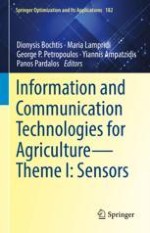This volume is the first (I) of four under the main themes of Digitizing Agriculture and Information and Communication Technologies (ICT). The four volumes cover rapidly developing processes including Sensors (I), Data (II), Decision (III), and Actions (IV). Volumes are related to ‘digital transformation” within agricultural production and provision systems, and in the context of Smart Farming Technology and Knowledge-based Agriculture. Content spans broadly from data mining and visualization to big data analytics and decision making, alongside with the sustainability aspects stemming from the digital transformation of farming. The four volumes comprise the outcome of the 12th EFITA Congress, also incorporating chapters that originated from select presentations of the Congress.
The focus in this volume is on different aspects of sensors implementation in agricultural production (e.g., types of sensors, parameters monitoring, network types, connectivity, accuracy, reliability, durability, and needs to be covered) and provides variety of information and knowledge in the subject of sensors design, development, and deployment for monitoring agricultural production parameters. The book consists of four (4) Sections. The first section presents an overview on the state-off-the art in sensing technologies applied in agricultural production while the rest of the sections are dedicated to remote sensing, proximal sensing, and wireless sensor networks applications.
Topics include: Emerging sensing technologies Soil reflectance spectroscopy LoRa technologies applications in agricultureWireless sensor networks deployment and applications Combined remote and proximal sensing solutions Crop phenology monitoring Sensors for geophysical properties Combined sensing technologies with geoinformation systems
